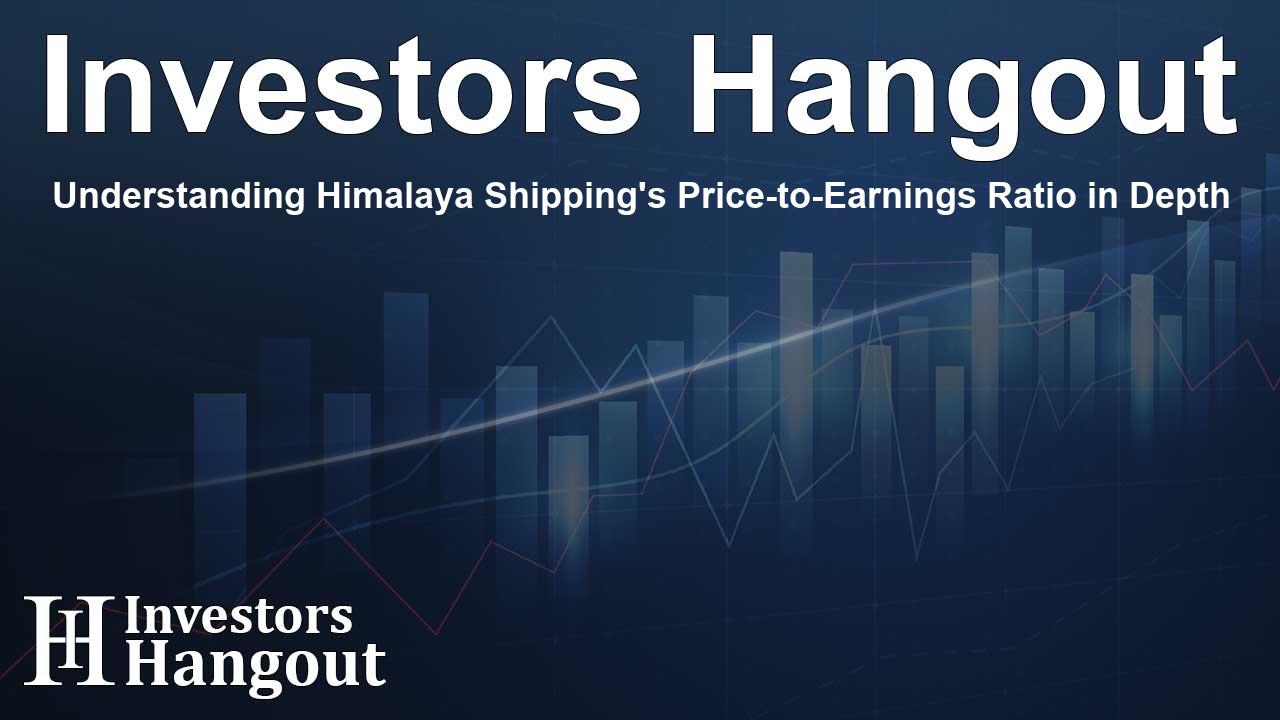Understanding Himalaya Shipping's Price-to-Earnings Ratio in Depth

An In-Depth Look at Himalaya Shipping's Financial Metrics
Currently, Himalaya Shipping Inc. (NYSE: HSHP) is experiencing a share price of $6.24, reflecting a decrease of 1.42% during the market session. This marks a modest uptick of 1.20% in the past month, but an unsettling drop of 24.91% when viewed over the last year. For long-term investors, the glaring question arises: is it time to examine the company's price-to-earnings (P/E) ratio?
Grasping the Significance of the Price-to-Earnings Ratio
The P/E ratio stands as a crucial metric that juxtaposes a company's current share price against its earnings per share (EPS). Analysts and investors utilize this figure to assess a company's present market performance in relation to its historical data and industry benchmarks like the S&P 500. Generally, a high P/E ratio suggests that investors foresee enhanced growth in the company’s future, which may translate to a stock that appears overvalued, at least on the surface, or that there’s eagerness to invest heavily in its potential dividends ahead.
Insights into Himalaya Shipping's P/E Compared to the Industry
Examining Himalaya Shipping's performance reveals a P/E ratio of 22.61. In contrast, the Marine Transportation industry has a notably lower aggregate P/E ratio of 12.92. This disparity may entice shareholders to anticipate superior long-term performance from Himalaya Shipping compared to its counterparts in the industry. However, this could also imply that the stock faces the risk of being considered overvalued.
Diving Deeper: Implications of the P/E Ratio
To synthesize, while the P/E ratio offers insights into the market's perception of a company's growth potential, it is essential to recognize its limitations. A lower P/E ratio could indicate an undervalued company; however, it might also signal a lack of expected growth amongst investors. Therefore, relying solely on the P/E ratio without considering broader industry trends and macroeconomic factors may lead to misguided decisions. Investors are best advised to adopt a holistic approach, incorporating various financial metrics alongside qualitative analyses when deliberating investment choices.
Market Performance: Factors to Consider
As analysts keep their eyes on Himalaya Shipping's financial trajectory, several external variables could impact its future. For one, industry dynamics such as supply chain disruptions, fuel price volatility, and increasing operational costs can dramatically influence profitability and stock performance in the Marine Transportation sector. Investors should also consider how geopolitical changes might affect shipping routes and regulations, directly influencing operational efficiencies.
Looking Ahead: Strategies for Investors
For shareholders aiming to make informed decisions, it's crucial to stay attuned to both macroeconomic indicators and micro-level company performance metrics. Continuous assessment of P/E ratios, coupled with evaluating a company’s strategic positioning within its industry, will better equip investors to navigate potential pitfalls. Moreover, engaging with financial news sources and trend analysis will provide deeper insights allowing for precise decision-making in a volatile market.
Frequently Asked Questions
What is a P/E ratio?
The P/E ratio compares a company's current share price to its earnings per share, indicating how much investors are willing to pay for $1 of earnings.
How is Himalaya Shipping performing in the current market?
Himalaya Shipping currently shows a share price of $6.24, having witnessed a slight decrease of 1.42% during the session.
Why is the P/E ratio important for investors?
The P/E ratio is vital for evaluating a stock's value and prospects, helping investors gauge whether a company is undervalued or potentially overvalued.
How does industry P/E compare to Himalaya Shipping's?
The Marine Transportation industry has an average P/E ratio of 12.92, whereas Himalaya Shipping exhibits a higher P/E of 22.61, suggesting expectations of superior performance.
What other factors should investors consider besides the P/E ratio?
Investors should consider industry trends, economic indicators, and qualitative factors impacting the company’s operational performance and market positioning.
About The Author
Contact Thomas Cooper privately here. Or send an email with ATTN: Thomas Cooper as the subject to contact@investorshangout.com.
About Investors Hangout
Investors Hangout is a leading online stock forum for financial discussion and learning, offering a wide range of free tools and resources. It draws in traders of all levels, who exchange market knowledge, investigate trading tactics, and keep an eye on industry developments in real time. Featuring financial articles, stock message boards, quotes, charts, company profiles, and live news updates. Through cooperative learning and a wealth of informational resources, it helps users from novices creating their first portfolios to experts honing their techniques. Join Investors Hangout today: https://investorshangout.com/
The content of this article is based on factual, publicly available information and does not represent legal, financial, or investment advice. Investors Hangout does not offer financial advice, and the author is not a licensed financial advisor. Consult a qualified advisor before making any financial or investment decisions based on this article. This article should not be considered advice to purchase, sell, or hold any securities or other investments. If any of the material provided here is inaccurate, please contact us for corrections.
